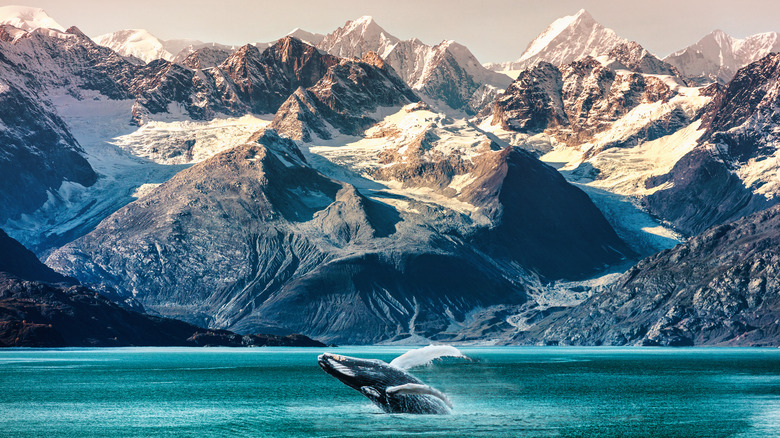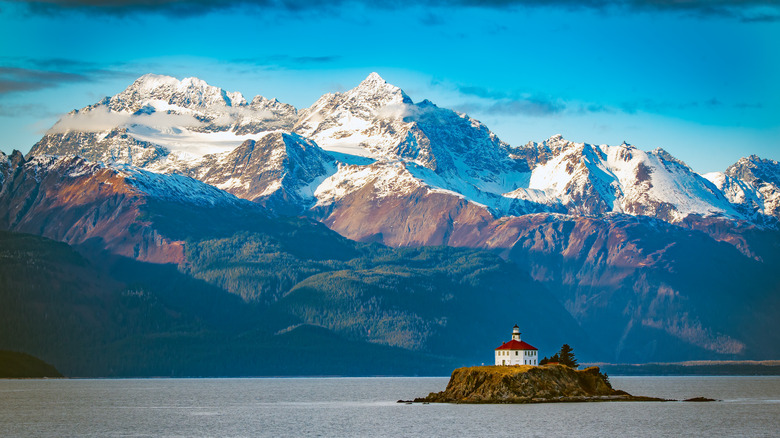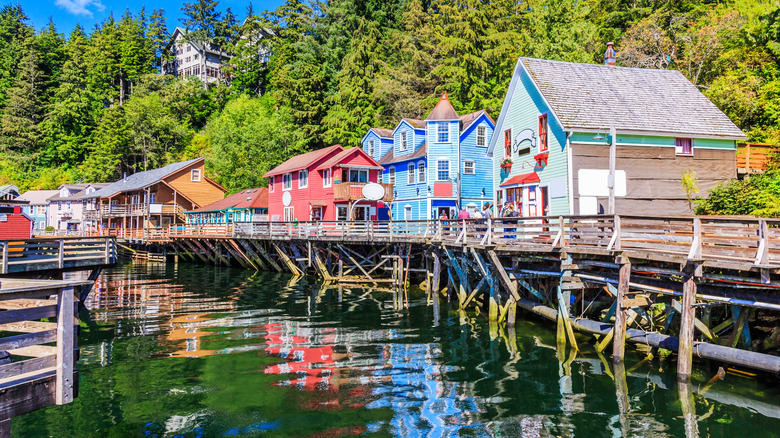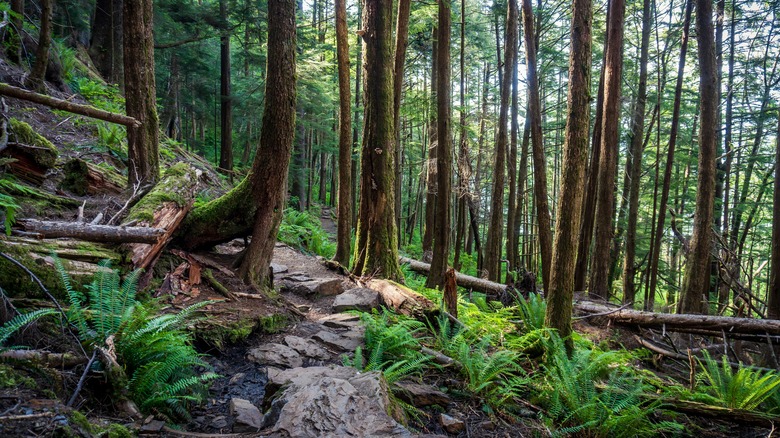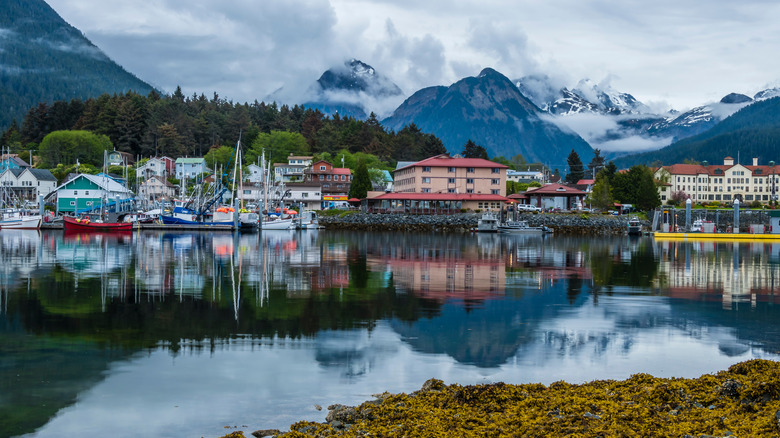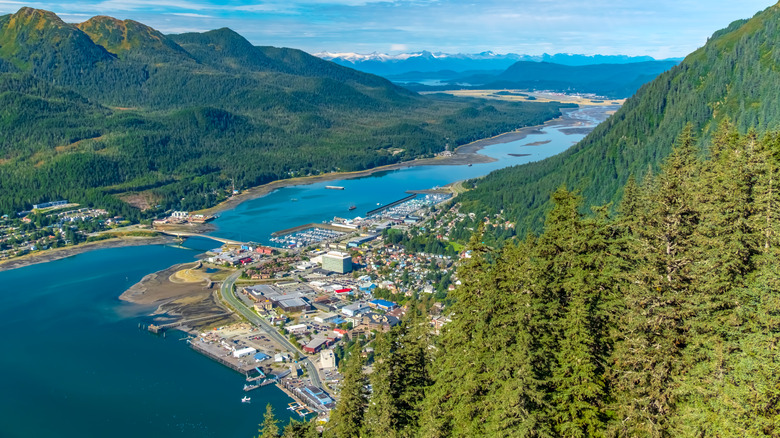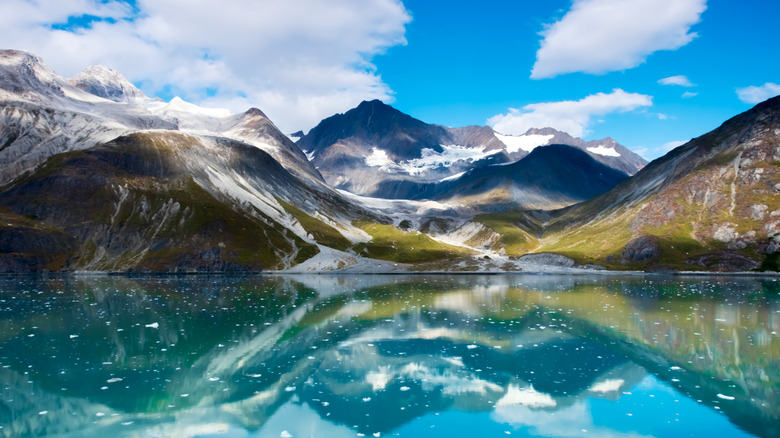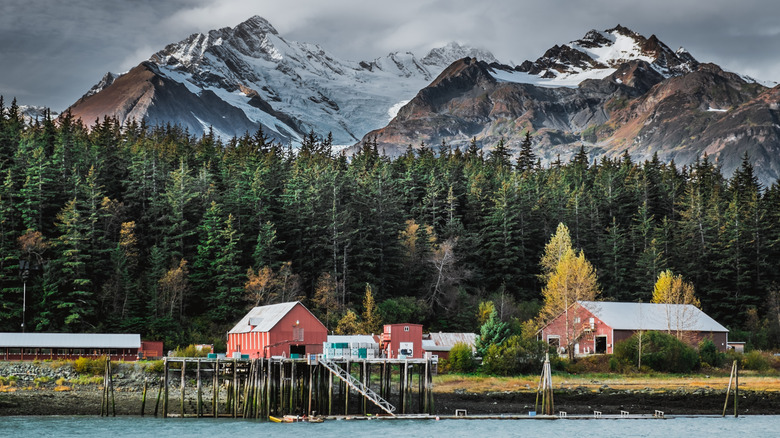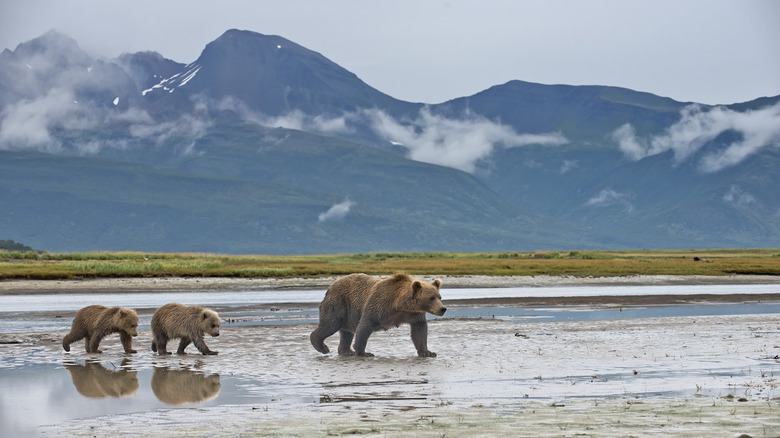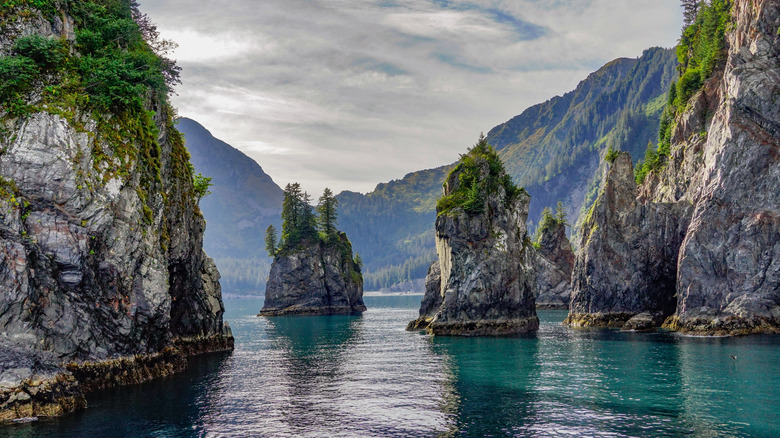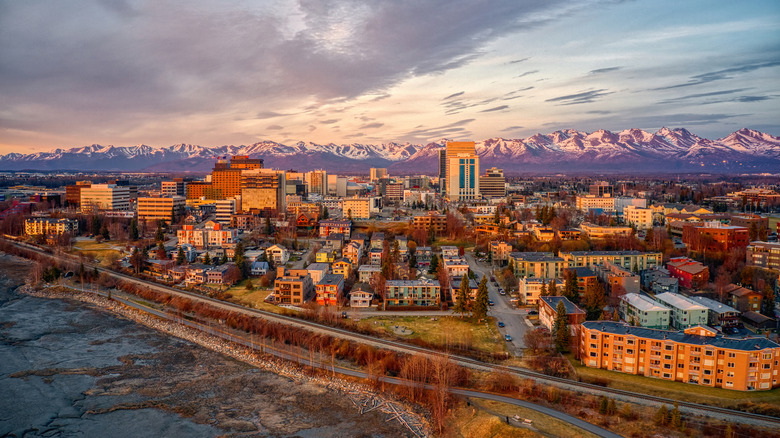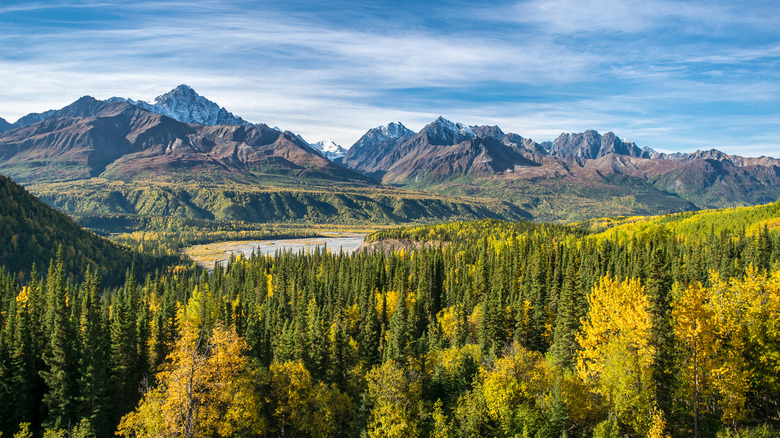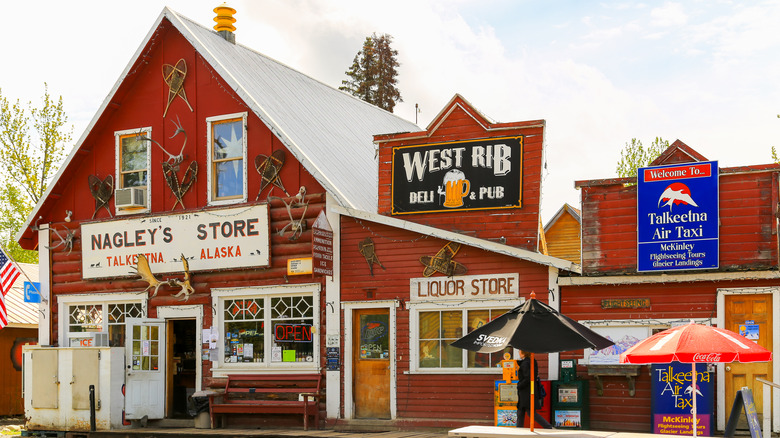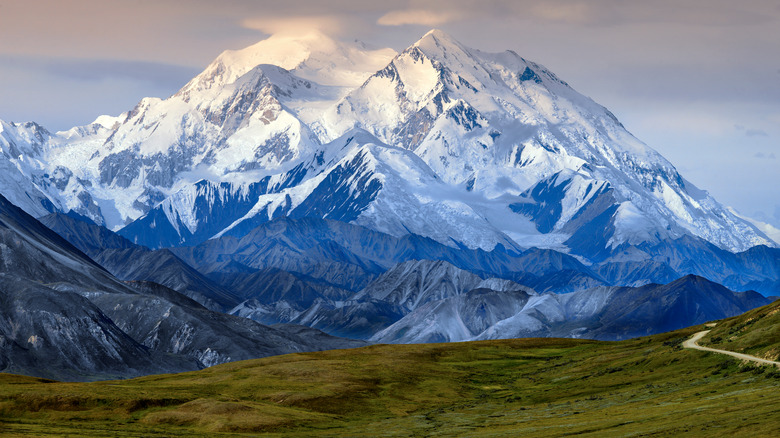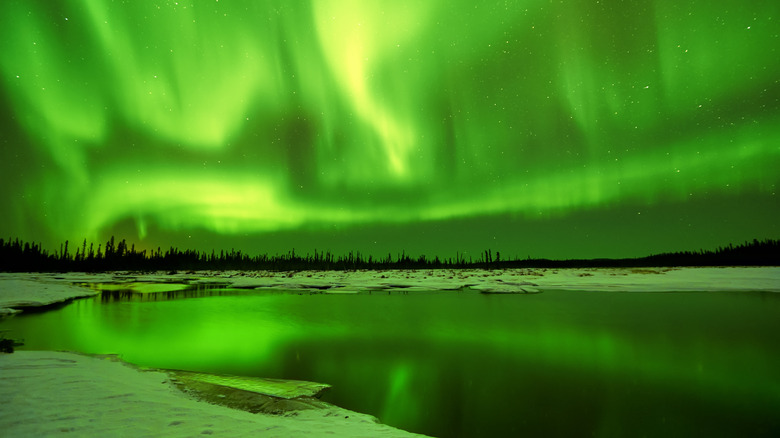14 Must-See Places In Alaska For First Time Visitors
It's no wonder why Alaska's nickname is "America's Last Frontier." Spanning over 400 million acres from tip to tip, many sections of this rugged state are only accessible by ferry or plane while others are traveled to on dirt roads. Covering the same length as the Lower 48 and as big as Texas, California, and Montana combined, the number of national parks in Alaska (eight) is a testament to its outstanding natural beauty. It is also brimming with history, from Russian occupation to the Gold Rush, and a tapestry of First Peoples heritage. Towering totem poles, sweeping scenery, and wildlife encounters like grizzly bears and wolves are just a glimpse of what you can expect on a first-time trip.
It's important for new Alaska visitors to keep in mind that much of the state is still remote, rugged, and untouched. While this certainly means there will be plenty of pristine wilderness to see, it also means that it can be inherently more dangerous. Wild animals, unpredictable weather conditions, and desolate roads are all factors that you might come face to face with. But if you're someone who likes the largest, biggest, or any other travel superlative, Alaska is the perfect destination. Using a mixture of information from Travel Alaska and Alaska's National Park Service, we've gathered together the perfect itinerary for those planning their very first trip to Alaska, whether you're a wildlife lover, history buff, bonafide adventurer, or have simply always wanted to see the 49th state.
Inside Passage
If you're looking for an easy way to see some of southern Alaska's most beautiful sights, look no further than a cruise along the Inside Passage. Stretching over 1,000 miles from Olympia, Washington, to Skagway, Alaska, the Inside Passage is a protected channel of water that follows a series of inlets and weaves past islands through the southern islands of the state. This is one of the most popular Alaskan cruise destinations as it avoids often rough seas and features truly stunning landscapes. Those who decide to set sail will witness craggy fjords, brilliant blue bays, and remote stretches of pristine coastline — along with frequent wildlife sightings like humpback whales, seals, and bald eagles soaring above.
From Glacier Bay National Park to the Tongass National Forest, these geographic accessories are just as beautiful as the gem of the Inside Passage itself. Pair this with the fact that the Inside Passage is dotted with some of Alaska's most interesting cities, like Ketchikan, and you have the perfect choice for a first-time trip.
Ketchikan
Ketchikan is a colorful town that's steeped in Alaskan history. If you decide to hop aboard an Alaskan cruise, chances are you'll make a pit stop here. The town's unique nickname, "Salmon Capital of the World," tells you most of why Ketchikan came to be in the first place, although the Gold Rush also had a huge effect. Nicknamed the "First City" because it was, well, the first city most people came across in Alaska, Ketchikan was also the largest city in the state in the early 1930s because of its plethora of salmon.
No visit to Ketchikan is complete without strolling down Creek Street. Once a hotbed of prostitution, now its historic buildings line the very salmon-spawning stream that brought the city to life. Dolly's is the oldest brothel in town, and you can't miss its iconic neon green paint. Aside from a history lesson or two, there are many fun things to do around town in the warmer months. The Great Alaskan Lumberjack Show features brawny men performing incredible feats like log rolling and sawing massive tree trunks, while the Misty Fjords National Monument's majestic waterfalls are just a seaplane ride away.
Ketchikan is known for its Tlingit heritage and is a great spot to seek out intricately carved totem poles. You can do so at the Totem Heritage Center or the Totem Bight Historical Park. One important factor to remember is that most of Ketchikan's main attractions close after mid-October.
Tongass National Forest
The Tongass National Forest is one of the largest temperate rainforests in the world. Once stretching all the way to Northern California, this is also the largest national forest in America. There's no end to the stunning views and wildlife encounters visitors will experience here, including bald eagles, salmon, and plentiful views of glaciers. Its proximity to Juneau and the cruises along the Inside Passage make it easy to visit and a marvelous addition to any Alaska itinerary for hikes along forest trails overrun by lush vegetation and carpets of peat bog.
The Mendenhall Glacier is located within the National Forest and is one of the most well-known glaciers in the state. You can see it from easy-access hiking trails, flightseeing tours, and cruises that approach it at a safe distance on Mendenhall Lake. Several trails afford the best views of this 12-mile-long glacier, including the Photo Point Trail and Nugget Falls Trail. Misty Fjords National Monument is also within the Tongass National Forest and is best explored on a day cruise. Visitors can see the dramatic waterfalls and abundant wildlife, all from the comfort of a heated boat. If you're feeling tired from your hiking adventures, seek out one of the Tongass' nearby hot springs on Chichagof Island, like the Tenakee Bath House.
Sitka
Situated on an island along the Pacific side of the Alexander Archipelago, Sitka is an important player in Alaskan history and a wildlife lover's paradise. In a way, Sitka is a tale of two cultures. Russia and the Tlingit peoples vied for control of the area for decades in the 18th and 19th centuries, long before Alaska became a U.S. territory and later a state in 1959. Tlingit and Russian influence can be seen all over town, from the Russian Blockhouse and Orthodox Church to the intricately carved totem poles.
Sitka is a great place to stop for first-timers because of its historic ties. 13% of the city's population is First Nations, and the heritage is beautifully represented across town. Dive into Tlingit culture while standing in the towering shadows of Sitka National Historical Park's 20 different totem poles. If you want to continue exploring the local culture through your tastebuds, stop by Pel'Meni for a steaming hot plate of potato dumplings.
Both the Alaska Raptor Center and Fortress of the Bear are wonderful places to see wildlife up close in Sitka. A safe and controlled atmosphere to see bears, the Fortress of the Bear is a local sanctuary for orphaned bears, while eagles, owls, falcons, and hawks are all rehabilitated at the Alaska Raptor Center, which takes in almost 200 injured birds a year.
Juneau
First-time visitors to Alaska shouldn't miss the chance to see the state capital, sitting along the edge of both the Inside Passage and the largest temperate rainforest in the world. Embrace one of Juneau's 250 hiking trails by day, discovering mountain vistas fringed with sprawling ocean views, and explore downtown by night through craft breweries and delicious seafood on the waterfront. Juneau's location makes it one of the best spots in Alaska for watching marine mammals, and humpbacks and orcas can be seen swimming off the city's shores from April to November.
Visitors can get the low down on Alaska's history at the Alaska State Museum, featuring exhibits and collections of local artifacts and Alaskan artists. The Goldbelt Tram takes visitors 1,800 feet above the city, and both the Timberline Bar & Grill and the Chilkat Center for the Arts sit at the top of the mountain. The sweeping views over the Gastineau Channel are spectacular.
Although there are many glaciers in Alaska, perhaps none capture the imagination quite like the Mendenhall Glacier with its turquoise coloring. The Mendenhall Glacier is located within the Tongass National Forest and is just a short drive away from Juneau by car.
Glacier Bay National Park
From snow-capped peaks to brilliant blue ocean, Glacier Bay National Park encompasses the varying terrain that you can only find in America's "Last Frontier." Glacier Bay is both a World Heritage site and a UNESCO biosphere reserve, which tells you a little something about its importance. Over 10,000 years of human history collide with millions of years of intricate geography. Even better, visiting Glacier Bay National Park is completely free!
Day tour boats and independent cruises are gorgeous ways to cruise Bartlett Cove and see glaciers up close. Visitors should carve out time to visit the park's totem poles and the Huna Tribal House to learn about Glacier Bay's Tlingit heritage. You can find the Healing Totem Pole at the Bartlett Cove dock while two others stand stoically at the Huna House itself.
As its name might suggest, there are over 1,000 different glaciers in Glacier Bay National Park. Tucked along the Inside Passage, just one of the dozens of reasons to cruise here, this area is best explored by boat, giving passengers an up close and personal view of the glaciers reflected in the sea. Kayaking is another way to connect with nature in Glacier Bay, gliding past giant slabs of ice, playful seals, and exploring the tidewaters. It's incredibly important for first-timers to join a guided tour, as the tides can be difficult to read for newcomers.
Haines
Nicknamed the "Adventure Capital of Alaska," Haines is one of those quirky little cities that feels like it's at the edge of the world. This is often one of the last stops along the Inside Passage and where many visitors hop off to explore more of the state's interior. Sandwiched between the Chilkoot and Chilkat Inlets, Haines is also one of the last cities as southern Alaska slowly bleeds into the Interior and Arctic in the far north.
True to Haines' nickname, there's an endless array of fun activities to take part in. You can easily join a river rafting expedition on the Alsek River, get a birds-eye view of the nearby fjords by flightseeing, or go rock climbing. One of the quirkiest things to do in town is visit the Hammer Museum. This was the first of its kind and features over 2,500 hammers, everything from primitive rocks to modern-day inventions. If you're itching to see the Gold Rush mecca of Skagway, hop on the Haines Skagway Fast Ferry for beautiful scenery and a fun way to get back and forth.
Katmai National Park
There's one big reason why most visitors make the trek out to Katmai National Park – brilliant, beautiful bears.
Katmai has one of the densest bear populations on Earth, a perfect storm of its remote terrain and the Brooks Stream becoming a bountiful sockeye salmon run in summer. Most of these ursine are grizzly bears who flock to the famous Brooks Falls to feast in preparation for their impending hibernation. July and September are the best times to witness this epic dining scene, and visitors can see the bears easily at Brooks Falls. You'll need to sign in at the Visitor Center and go through a quick "Bear School" beforehand.
Sitting on the precipice of the Aleutian Islands at the start of the Alaska Peninsula, Katmai National Park is utterly remote. This is one of the wildest places in Alaska, with unpredictable weather, dense wildlife, and sweeping mountain vistas, but its rugged beauty only adds to its magical qualities. The park was designated after a cataclysmic eruption known as the Novarupta in the early 1900s. This volcanic eruption was larger than both Vesuvius and Krakatau and led to an uptick in scientific research. Destinations in the park, like the inspiring Valley of Ten Thousand Smokes, were created in the event. A visit to this park is reserved for true adventurers but makes for an unforgettable trip, especially if this is your first time in Alaska.
Kenai Fjords National Park
Kenai Fjords National Park showcases Alaska's cherished — and truly jaw-dropping — fjords. Thousands of years in the making, their beautiful and unique geography was carved by glaciers and is something you can't find anywhere else in America. Visitors can explore by land, driving right up to the park's famous Exit Glacier, but kayaking and boat tours are some of the best ways to see the park's seaside scenery and marine wildlife. Kayaking these waters will transport you back to when human-powered travel was the only option.
For visitors looking to explore by land, head to the Harding Icefield Trail. This 8.2-mile hike is challenging, with thousands of miles of elevation gain, but ends with striking views of the Exit Glacier's ice field. Consider staying in the park's Coastal Public Use Cabins, an incredible accommodation option within the park perfect for the adventurous.
It's no secret that Kenai Fjords is difficult to access, and first-timers should utilize the park's facilities and tours from nearby towns to get around. The quaint town of Seward is on the doorstep of Kenai Fjords National Park and is one of the best bases for adventuring in this stunning natural space. Boat tours of the park also leave daily from Seward in the summer months. Hot tip: Make sure to bundle up, even in Alaska's summer season, as these cruises can be surprisingly chilly!
Anchorage
Anchorage is the largest city in Alaska yet still retains the state's rugged spirit. Ringed by snow-capped peaks, visitors can experience the great outdoors by trekking across glaciers, snowmobiling, or witnessing breaching humpbacks. Anchorage is also one of the best places to uncover Alaskan history through the city's many museums, such as the Alaska Native Heritage Center. There's no shortage of things to do here, which makes it one of the best places to visit for a first trip.
Like Fairbanks, Anchorage also experiences the Midnight Sun, and sometimes the aurora borealis makes an appearance, although both of these phenomena are less exaggerated. Anchorage is the start of the Iditarod, a legendary sled dog race that ends in Nome, up to 1,000 miles away. Being in town for the kick-off in March is a once-in-a-lifetime experience, and you can even try your hand at dog sledding any time of year! If you want to partake in more truly Alaskan adventure, sign up for gold panning at the historic Crow Creek Gold Mine.
Cheers to your time in Anchorage with the city's claim to fame — the Duck Fart. While the name certainly doesn't sound appetizing, this one-of-a-kind cocktail is unique to Alaska and made from a combination of Kahlua, Baileys, and whiskey — the perfect medley to warm you up from the inside. Yum!
Wrangell-St. Elias National Park
Wrangell-St. Elias is the largest national park in the United States, sweeping across 13.2 million Alaskan acres. The park spans from the Canadian border to the remote Richardson Highway in the west and is an exciting addition to a first-time trip. If you want to get a slice of off-the-beaten-path Alaska, this is one of the best ways to do it! Your first stop should be at one of several Visitor Centers scattered throughout the park. These are your headquarters for information about this remote area and great places to pick the park ranger's brains about their recommendations.
While Wrangell-St. Elias reveals a tremendous amount of Alaska's trademark natural scenery, it has few services, roads can become treacherous, and visitors should prepare for its isolation. The park is broken up into several regions based on road access. Kennecott is one of the best sections with bonafide Gold Rush towns, mines, and beautiful glacier hikes. The Kennecott Mines National Landmark is located within the park and includes an interpretive village and exhibits. You can even tour the mine itself with St. Elias Alpine Guides. Visitors should also consider a flightseeing tour, one of the best ways to see the sheer size of Wrangell-St. Elias National Parl.
Talkeetna
Talkeetna is an artsy community of just 1,200 people tucked away north of Anchorage. This little city was once a Gold Rush boomtown but is now a popular staging area for ascents of Denali. You might even see the "Great One" (Denali's nickname) from town on a clear day. You'll probably spend your first moments in Talkeetna strolling down the historic main street, so pop into Nagley's Store to fuel up with a cappuccino and check out the National Historic Register-listed property yourself.
Visitors can participate in activities paying homage to Talkeetna's many historic phases by gold panning, riding the Alaskan Railroad, or hiking in the nearby Denali National Park. Although many Alaskan towns offer flightseeing, a tour from Talkeetna, with views of Denali, is arguably the best in the entire state.
If seeing the climbers and trekkers preparing for their ascent of Denali has piqued your interest, head to the Talkeetna Historical Society Museum. The nearby memorial at Talkeetna Cemetery dedicated to the climbers who never made it off the mountain is another solemn sight. End your swing through town at the Denali Brewing Company, sipping on a Mother Ale. They also own the Alaska Cider Works and Alaska Meadery if you favor the sweet stuff.
Denali National Park
If ever there was a place to visit in Alaska deserving the nickname "America's Last Frontier," Denali is it. The tallest peak in North America sits at the center of Denali National Park. Once called Mount McKinley, its Athabascan name of Denali was resurrected in 1980. The mountain draws 600,000 visitors annually, making it one of the most popular national parks in Alaska.
If you hope to see wildlife on your trip to Alaska, you've come to the right place. Denali is home to "The Big Five," namely grizzly bears, caribou, moose, wolves, and Dall sheep. With over 6 million acres of wilderness to explore, it can be difficult to know where to start. One main road cuts through the heart of the park, and it can only be driven with private vehicles to Mile 15, another great reason to hop on a park bus. Denali's bus system is extensive, and you'll want to try and ride it as far as possible for your best chances of seeing animals and magnificent mountain views. The bus stops for restroom breaks, wildlife encounters, and, of course, the incredible scenery.
Although it's possible to visit Denali no matter the time of year, winter can be desolate, and most park services are limited or closed. This can also be a magical time to visit as dangerous wildlife encounters are minimized, and the park is blanketed with snow.
Fairbanks
Aptly nicknamed the "Golden Heart City," Fairbanks was at the very heart of Alaska's Gold Rush. Sitting just below the Arctic Circle in Interior Alaska, Fairbanks experiences both the swirling Northern Lights and summer's Midnight Sun, giving visitors from the Lower 48 a special treat. If it's your first trip to Alaska, this is one city you can't miss. First-timers hoping to catch a glimpse of the aurora borealis without venturing too far off the beaten path, this is your golden ticket.
Fairbanks' Museum of the North deserves a dedicated visit if not for its iconic antler arch alone. The famous Magic Bus from "Into the Wild" was once near Denali National Park but has been displayed at the Museum of the North since 2020. The Morris Thompson Cultural Center is another excellent stop if you are interested in Alaskan history and features interesting exhibits on Athabascan culture and Interior Alaska.
You can't leave Fairbanks without trying some of the local specialties like reindeer and Yukon potatoes, of course! The Pump House is the best place in town to grab a bite to eat, with a nostalgic interior and delightful terrace for when the weather is good.
